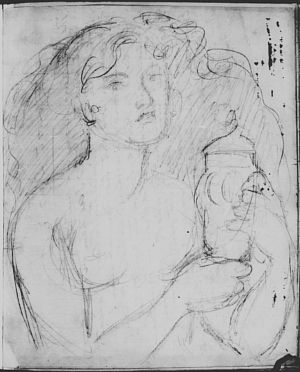Included Text
Design for the Magdalene Crayon
Note: Charles Fairfax Murray's note appears at the top left of this page.
- The lost days of my life until to-day,
- What were they, could I see them on the street
- Lie as they fell? Would they be ears of wheat
- Sown once for food but trodden into clay?
- Or golden coins squandered and still to pay?
- Or drops of blood dabbling the guilty feet?
- Or such spilt water as in dreams must cheat
- The throats of men in Hell, who thirst alway?
- I do not see them here; but after death
- God knows I know the faces I shall see, 10
- Each one a murdered self, with low last breath.
- ‘I am thyself,—what hast thou done to me?’
- ‘And I—and I—thyself,’ (lo! each one saith,)
- ‘And thou thyself to all eternity!’
Note: The poem appears on the verso of the drawing.

Scholarly Commentary
Introduction
This splendid sketch may be an early study for DGR's Venus Verticordia , probably done in 1863 or 1864. The picture should be compared with another early pencil study (in the Birmingham City Museum and Art Gallery).
The drawing is located on the verso of page 104 in the Fitzwilliam Museum's composite manuscript of “The House of Life”. A note by Charles Fairfax Murray on the manuscript indicates his view that the picture is actually a study for Mary Magdalene . It seems far more closely related to another drawing in that manuscript, however, the Woman Standing Behind a Table —and through that relation to a large constellation of other pictures and textual works (see the commentary for Woman Standing Behind a Table ).
On the other side of the sheet is DGR's (cancelled) text of the sonnet “ Lost Days”, which he wrote in 1862 soon after the death of his wife. Whether DGR imagined any relation between the sonnet and the picture is unclear.
Bibliography